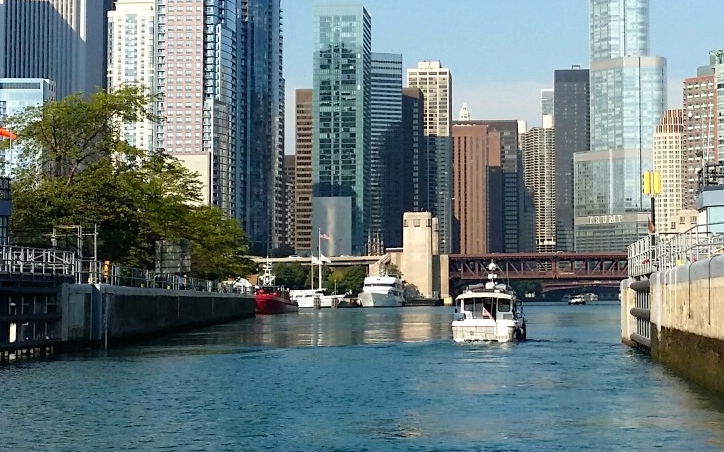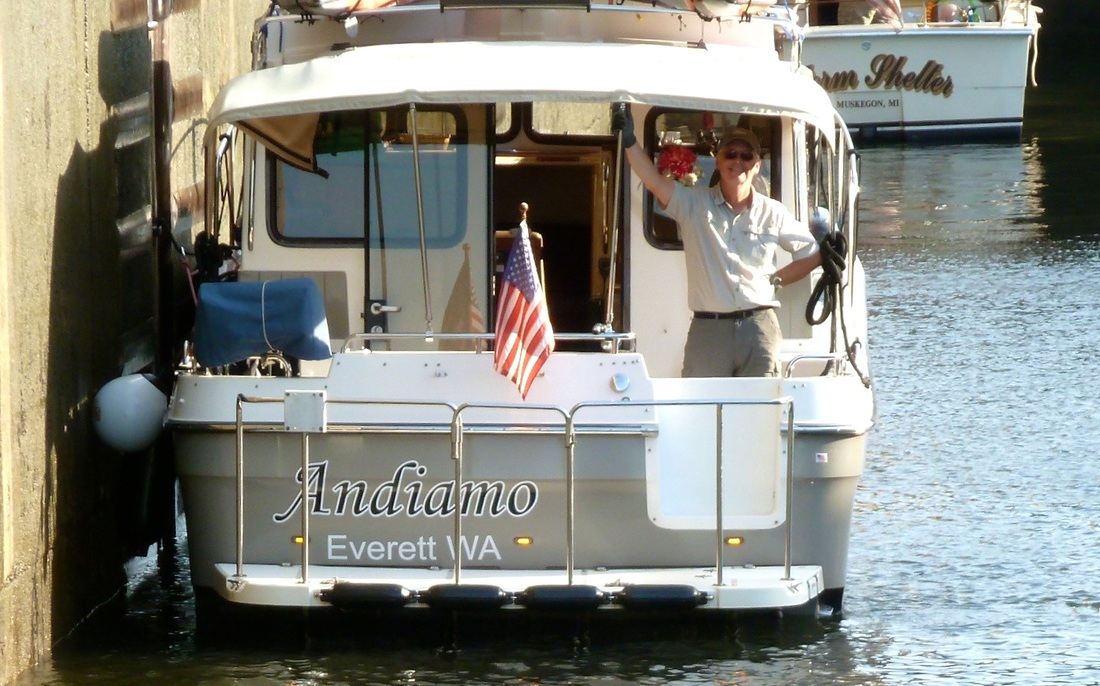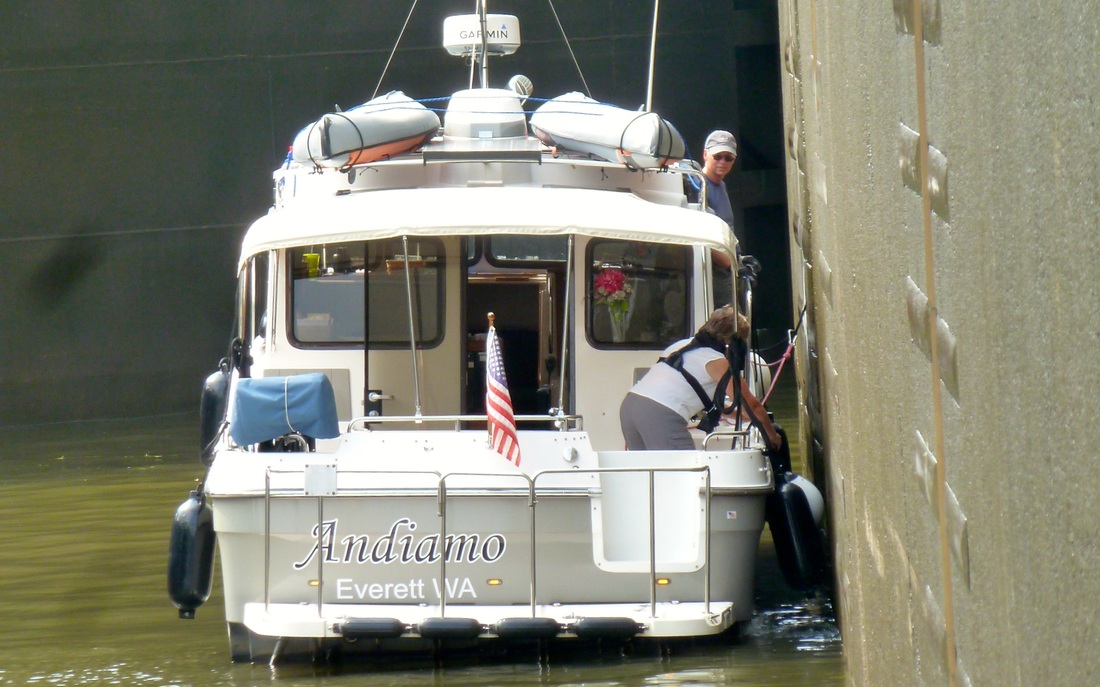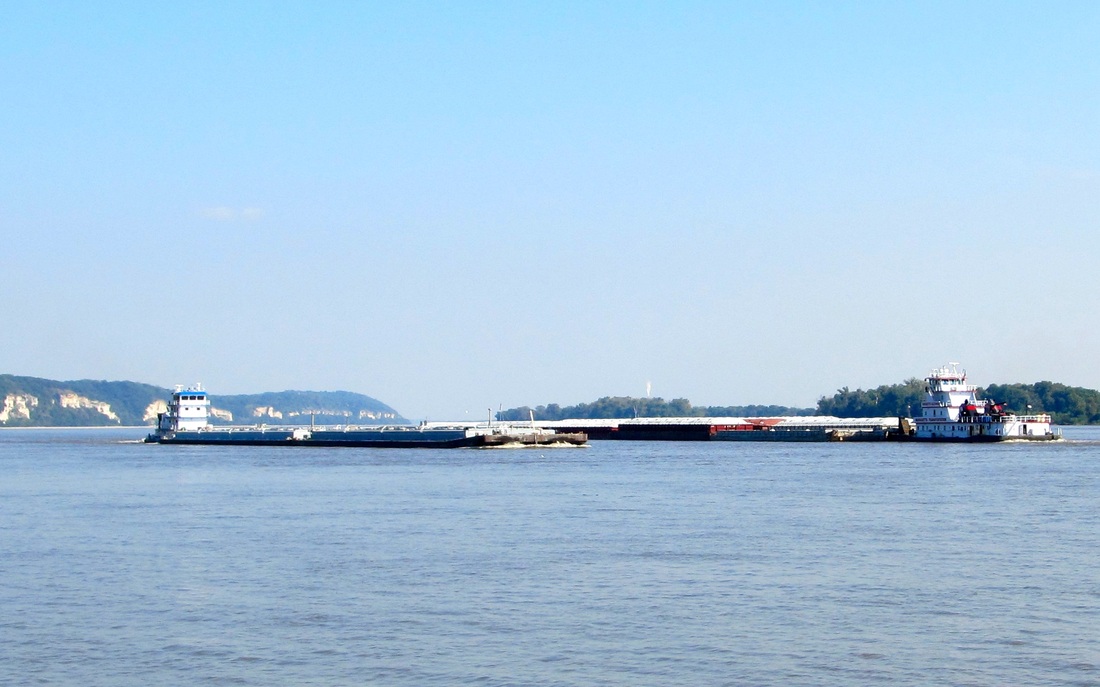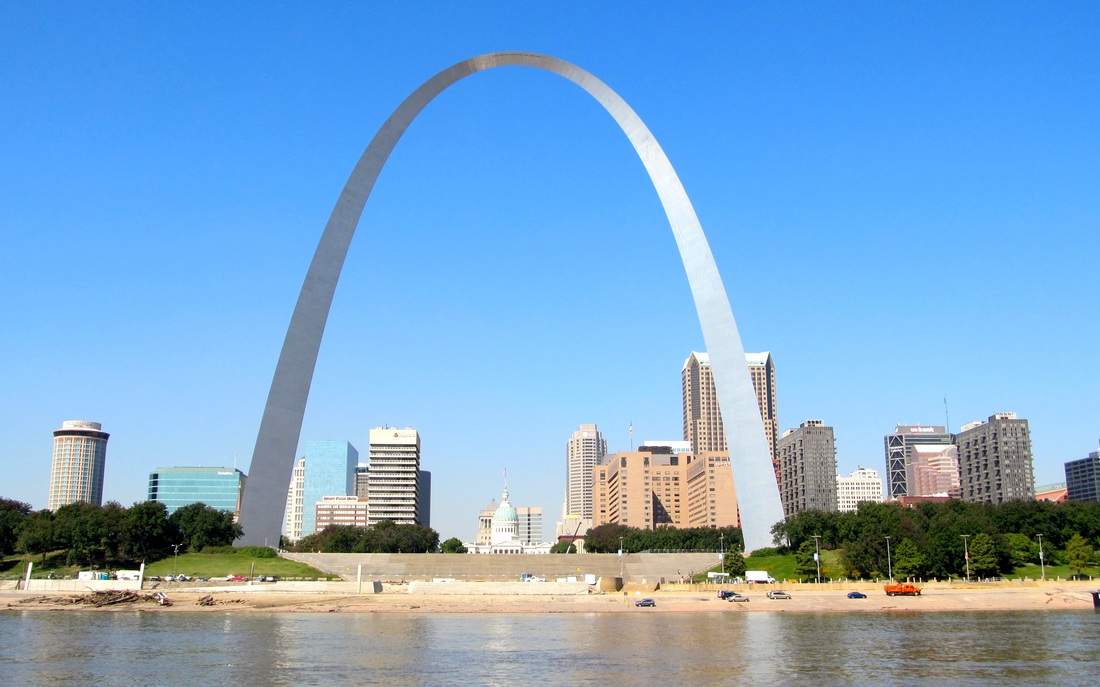Wednesday, September 17: CHICAGO
The bikes were set up and we enjoyed the location of this marina; in the heart of downtown, close to the Navy Pier, the museums, next to the bike and walking path, and easy access to the heart of the city. We rode the wide and beautiful path along Lakeshore Drive, riding north for several miles before turning around, walked through the Navy Pier, and then rode south past the marina to the museums that would be explored tomorrow.
The sound and pace of this city was a stark contrast to the small towns that were experienced for the past two months. We had been to Chicago several times so we did not need to spend a lot of time here. While relaxing in the cockpit, we met Ken who has a boat at the marina and tries to meet all the loopers that come. He gave recommendations for food and shopping and was very gracious and helpful; flying the AGLCA burgee creates these opportunities.
We took Ken’s advice and found a small take-out restaurant and had great Chinese food on the tug. In the early evening, sailboats were leaving in mass for an event that probably happens every Wednesday night during the boating season. In the upper Midwest, boaters are serious and committed because they only have 16 to 20 weeks to get their fix and adventures done.
The bikes were set up and we enjoyed the location of this marina; in the heart of downtown, close to the Navy Pier, the museums, next to the bike and walking path, and easy access to the heart of the city. We rode the wide and beautiful path along Lakeshore Drive, riding north for several miles before turning around, walked through the Navy Pier, and then rode south past the marina to the museums that would be explored tomorrow.
The sound and pace of this city was a stark contrast to the small towns that were experienced for the past two months. We had been to Chicago several times so we did not need to spend a lot of time here. While relaxing in the cockpit, we met Ken who has a boat at the marina and tries to meet all the loopers that come. He gave recommendations for food and shopping and was very gracious and helpful; flying the AGLCA burgee creates these opportunities.
We took Ken’s advice and found a small take-out restaurant and had great Chinese food on the tug. In the early evening, sailboats were leaving in mass for an event that probably happens every Wednesday night during the boating season. In the upper Midwest, boaters are serious and committed because they only have 16 to 20 weeks to get their fix and adventures done.
The next day started with a cool morning with big clouds sitting on top of the skyline that would burn off by mid-morning. After breakfast, three quarters of Andiamo was cleaned with vinegar and water and the black marks and abrasions in the gel coat were buffed out. The tug was gleaming again with most of the Lake Michigan water spots removed.
The day’s exploration started with the bikes taking us to the 24-acre Millennium Park that was close by. Then, we rode to the Field’s Museum that is one of the premiere natural history museums in the country and most of the day was spent there. Amazing exhibits. The museum is like a stew where the exhibits are like a stew’s ingredients of different parts of the world that are not connected by any theme. Afterwards, Laurie found Mariano’s Market that was an amazing urban market with great prices while I walked Michigan Drive. The day was closed with Chicago pizza delivered to the tug.
The day’s exploration started with the bikes taking us to the 24-acre Millennium Park that was close by. Then, we rode to the Field’s Museum that is one of the premiere natural history museums in the country and most of the day was spent there. Amazing exhibits. The museum is like a stew where the exhibits are like a stew’s ingredients of different parts of the world that are not connected by any theme. Afterwards, Laurie found Mariano’s Market that was an amazing urban market with great prices while I walked Michigan Drive. The day was closed with Chicago pizza delivered to the tug.
Friday, September 19: TRAVELING THROUGH DOWNTOWN CHICAGO
Andiamo was straining against her lines before sunrise, a sure sign that the wind had come up. When we would leave, Lake Michigan would greet us with big rollers from the southeast that went over the breakwater. It would be a short but interesting trip to the Chicago Lock.
At the dock we met Lori who is cruising to Florida with her husband Gray and their 5-month-old child in an older Carver cruiser. They are from the Toronto area and started the trip just a few days ago. I had seen the boat and her at the St. Joseph Harbor. They were going to Joliet and would leave Chicago before we would.
After breakfast, the water tank was filled and Andiamo left the marina for the Chicago Lock that is the barrier between Lake Michigan and the Chicago Sanitary and Ship Canal that is the waterway that goes through downtown Chicago, connects with the Cal-Sag Canal and becomes the Illinois Waterway that would be our route to the Mississippi River. The Sanitary and Ship Canal used to run into Lake Michigan until the complaints about the sewage and pollutants from the other cities that use Lake Michigan as their drinking water. The amount of lift or drop from the Chicago Lock is minimal. Not all loopers go this route because the bridge height of 17 feet forces the bigger and taller cruisers to take the Cal-Sag Canal and they miss the downtown.
Immediately after leaving the slip that was in the shadow of a huge ship that is used by the Columbia Yacht Club as their building, Andiamo was assaulted with a stiff wind and 2 foot rolling swells. And this was behind a breakwater! The boats in the massive mooring field were pitching and rolling wildly as the swells rolled under them. When Andiamo cleared the protection of the breakwater, the tug had to deal with 5-foot high swells for the mile long trip to the Chicago Lock. Lake Michigan was giving us a last punch, a memorable send-off, just in case our memories of being on the lake had softened since being in Chicago.
The gates of this, the second busiest lock in the United States were closed and the lockmaster said that another barge was coming into the lock from the city. The barge was an Army Corps of Engineers maintenance crew and they would spend an hour in the lock as we idled around in the lee side of the lock and their building trying to find some peace from the raging lake before the gates opened. This was the funkiest lock we had been in because the lock lines were so short and so badly frayed and worn and the lift or the drop was minimal. But, going through the Chicago Lock, put Lake Michigan behind us and opened up the downtown.
Simply, the transit was splendid as we idled along, going under 24 bridges in 5 miles with skyscrapers on each side that blocked out the sun. The sound was cars and buses. The senses were overwhelmed with everything about people and humanity. Everything was human-made; it was highly evolved urban living, and a tribute to man’s innovation, ingenuity, and determination. Seeing, hearing, and feeling all of this from a boat multiplied the magnificence of the experience. We knew that that we were experiencing one of the highlights of this adventure.
Andiamo was straining against her lines before sunrise, a sure sign that the wind had come up. When we would leave, Lake Michigan would greet us with big rollers from the southeast that went over the breakwater. It would be a short but interesting trip to the Chicago Lock.
At the dock we met Lori who is cruising to Florida with her husband Gray and their 5-month-old child in an older Carver cruiser. They are from the Toronto area and started the trip just a few days ago. I had seen the boat and her at the St. Joseph Harbor. They were going to Joliet and would leave Chicago before we would.
After breakfast, the water tank was filled and Andiamo left the marina for the Chicago Lock that is the barrier between Lake Michigan and the Chicago Sanitary and Ship Canal that is the waterway that goes through downtown Chicago, connects with the Cal-Sag Canal and becomes the Illinois Waterway that would be our route to the Mississippi River. The Sanitary and Ship Canal used to run into Lake Michigan until the complaints about the sewage and pollutants from the other cities that use Lake Michigan as their drinking water. The amount of lift or drop from the Chicago Lock is minimal. Not all loopers go this route because the bridge height of 17 feet forces the bigger and taller cruisers to take the Cal-Sag Canal and they miss the downtown.
Immediately after leaving the slip that was in the shadow of a huge ship that is used by the Columbia Yacht Club as their building, Andiamo was assaulted with a stiff wind and 2 foot rolling swells. And this was behind a breakwater! The boats in the massive mooring field were pitching and rolling wildly as the swells rolled under them. When Andiamo cleared the protection of the breakwater, the tug had to deal with 5-foot high swells for the mile long trip to the Chicago Lock. Lake Michigan was giving us a last punch, a memorable send-off, just in case our memories of being on the lake had softened since being in Chicago.
The gates of this, the second busiest lock in the United States were closed and the lockmaster said that another barge was coming into the lock from the city. The barge was an Army Corps of Engineers maintenance crew and they would spend an hour in the lock as we idled around in the lee side of the lock and their building trying to find some peace from the raging lake before the gates opened. This was the funkiest lock we had been in because the lock lines were so short and so badly frayed and worn and the lift or the drop was minimal. But, going through the Chicago Lock, put Lake Michigan behind us and opened up the downtown.
Simply, the transit was splendid as we idled along, going under 24 bridges in 5 miles with skyscrapers on each side that blocked out the sun. The sound was cars and buses. The senses were overwhelmed with everything about people and humanity. Everything was human-made; it was highly evolved urban living, and a tribute to man’s innovation, ingenuity, and determination. Seeing, hearing, and feeling all of this from a boat multiplied the magnificence of the experience. We knew that that we were experiencing one of the highlights of this adventure.
ONWARD TO PEORIA: 4 DAYS
After about 10 miles, the urban area had faded away and was replaced by heavy industrial, the past economic engine that created the opportunity to build the urban core. Relics of the past, broken infrastructure, aging rail transportation, and pipelines and tank farms were the scenery. We were not on the original canal. The Illinois-Michigan Canal was hand dug by immigrants and before it could be useful, the railroad made it obsolete and it came an open sewer. We are good at building and poor at disposing; forward thinkers are rewarded, dealing with consequences has always been a weakness of our culture.
After the junction with the Cal-Sag Canal, the number of barges on the shoreline was huge; waiting to be loaded or off-loaded. Known as “12 miles of hell” the water is all about barges and the tugs that move them. Today, the tug traffic was very light; maybe the crews have Fridays off.
At 1:30 PM Andiamo came to the Evasive Species Prevention Barrier, or simply known as the fish barrier that is intended to stop the Asian Carp from entering the Great Lakes. The eco-system of the Great Lakes had been dramatically altered in the last 200 years by the introduction of evasive species. Substantial efforts were being made to not have a repeat experience.
We were stopped before the fish barrier because divers were in the water and installing the electrical lines that will create an electrical field that will stop the Asian Carp from going farther. Two other looper boats were waiting, Lori and Gray on their Carver and a Kadey-Krogen named Chesapeake. We were told to tie to the wall but the limestone wall was rough and deteriorating. Chesapeake offered the opportunity for Andiamo to raft to them, another example of serendipity, and we accepted. We would wait for over two hours and had a nice conversation with Joe and Connie who have been cruising for over 6 years.
The destination was Joliet, population 147,000, and their free wall. The Lockport dam and lock had to be transited first and though the wait was minimal, the lock took 40 minutes to drop about 40 feet. This lock was our first experience since Lake Erie with floating bollards that are recessed into lock wall. We had to figure that out on the fly but we adapted, overcome and learned how to do it better. Locking down, or going downstream is always easier because there is less turbulence in the lock and makes a great place to re-learn skills.
At about 5:30 PM, we arrived at the wall in downtown Joliet and were the only boats there. Andiamo had traveled 43 miles in 8 hours. Locks, closures and slow speeds made the day longer.
After about 10 miles, the urban area had faded away and was replaced by heavy industrial, the past economic engine that created the opportunity to build the urban core. Relics of the past, broken infrastructure, aging rail transportation, and pipelines and tank farms were the scenery. We were not on the original canal. The Illinois-Michigan Canal was hand dug by immigrants and before it could be useful, the railroad made it obsolete and it came an open sewer. We are good at building and poor at disposing; forward thinkers are rewarded, dealing with consequences has always been a weakness of our culture.
After the junction with the Cal-Sag Canal, the number of barges on the shoreline was huge; waiting to be loaded or off-loaded. Known as “12 miles of hell” the water is all about barges and the tugs that move them. Today, the tug traffic was very light; maybe the crews have Fridays off.
At 1:30 PM Andiamo came to the Evasive Species Prevention Barrier, or simply known as the fish barrier that is intended to stop the Asian Carp from entering the Great Lakes. The eco-system of the Great Lakes had been dramatically altered in the last 200 years by the introduction of evasive species. Substantial efforts were being made to not have a repeat experience.
We were stopped before the fish barrier because divers were in the water and installing the electrical lines that will create an electrical field that will stop the Asian Carp from going farther. Two other looper boats were waiting, Lori and Gray on their Carver and a Kadey-Krogen named Chesapeake. We were told to tie to the wall but the limestone wall was rough and deteriorating. Chesapeake offered the opportunity for Andiamo to raft to them, another example of serendipity, and we accepted. We would wait for over two hours and had a nice conversation with Joe and Connie who have been cruising for over 6 years.
The destination was Joliet, population 147,000, and their free wall. The Lockport dam and lock had to be transited first and though the wait was minimal, the lock took 40 minutes to drop about 40 feet. This lock was our first experience since Lake Erie with floating bollards that are recessed into lock wall. We had to figure that out on the fly but we adapted, overcome and learned how to do it better. Locking down, or going downstream is always easier because there is less turbulence in the lock and makes a great place to re-learn skills.
At about 5:30 PM, we arrived at the wall in downtown Joliet and were the only boats there. Andiamo had traveled 43 miles in 8 hours. Locks, closures and slow speeds made the day longer.
Saturday, September 20
Laurie felt the half-dozen wakes from the barges that slipped by the tug during the night though I did not. The destination was Ottawa about 36 miles away and that faded away when the lockmaster at the nearby Brandon Lock said the commercial barge traffic would delay us by several hours. The other factor was an approaching line of thunderstorms from Iowa and the National Weather Service had issued severe weather warning for the early afternoon.
For the past several months, nature was the reason to adapt; now its humans, the Army Corps of Engineers and towboats.
We walked, wrote, and talked with Joe and Connie and Gray and Lori, whose VHF radio was not working. The Doppler radar on Weatherbug was used to watch the approach of the thunderstorms and the Garmin AIS showed the locations of some of the tows. The older tugs apparently were grandfathered into the pre-AIS rules.
Late morning and the three boats were in the Brandon Lock where we waited 45 minutes. This part of the river does not freeze because, as a local said, “The river is too polluted to freeze.” Eight miles later came the Big Basin Marina and the heavy rain started. Andiamo dove into the marina and when there was no response on the VHF radio or by telephone, we were directed to a vacant slip by other renters. The slip was tight and short but the tug slipped in. Andiamo created such a stir in this sea of Carvers, Sea Rays and Prowlers that many hands came to help.
It was a short travel day due to the tows and weather with Andiamo traveling 10 miles in 2 hours.
The marina was too tight for Joe and Connie in Chesapeake and Lori and Gray were following them. They continued onward in the rain.
The heavy rain lasted about an hour. However, the 30-mile an hour wind did not materialize and just as we thought about moving on, another band of thunder and lightning arrived. Andiamo would stay the night. Big Basin was described by the users as a “working man’s marina” where there is no dockmaster, few rules, no diesel, and the closest restaurant is a biker bar. But it had the basics, was a refuge harbor and charged .75 a foot. We were fine with it. During the afternoon and early evening, everyone in this small marina came to visit and talk and some wanted a tour.
The evening was closed with steaks, salad and a movie.
Laurie felt the half-dozen wakes from the barges that slipped by the tug during the night though I did not. The destination was Ottawa about 36 miles away and that faded away when the lockmaster at the nearby Brandon Lock said the commercial barge traffic would delay us by several hours. The other factor was an approaching line of thunderstorms from Iowa and the National Weather Service had issued severe weather warning for the early afternoon.
For the past several months, nature was the reason to adapt; now its humans, the Army Corps of Engineers and towboats.
We walked, wrote, and talked with Joe and Connie and Gray and Lori, whose VHF radio was not working. The Doppler radar on Weatherbug was used to watch the approach of the thunderstorms and the Garmin AIS showed the locations of some of the tows. The older tugs apparently were grandfathered into the pre-AIS rules.
Late morning and the three boats were in the Brandon Lock where we waited 45 minutes. This part of the river does not freeze because, as a local said, “The river is too polluted to freeze.” Eight miles later came the Big Basin Marina and the heavy rain started. Andiamo dove into the marina and when there was no response on the VHF radio or by telephone, we were directed to a vacant slip by other renters. The slip was tight and short but the tug slipped in. Andiamo created such a stir in this sea of Carvers, Sea Rays and Prowlers that many hands came to help.
It was a short travel day due to the tows and weather with Andiamo traveling 10 miles in 2 hours.
The marina was too tight for Joe and Connie in Chesapeake and Lori and Gray were following them. They continued onward in the rain.
The heavy rain lasted about an hour. However, the 30-mile an hour wind did not materialize and just as we thought about moving on, another band of thunder and lightning arrived. Andiamo would stay the night. Big Basin was described by the users as a “working man’s marina” where there is no dockmaster, few rules, no diesel, and the closest restaurant is a biker bar. But it had the basics, was a refuge harbor and charged .75 a foot. We were fine with it. During the afternoon and early evening, everyone in this small marina came to visit and talk and some wanted a tour.
The evening was closed with steaks, salad and a movie.
The next morning, the creak of the lines before sunrise was the first indication of the moderate breeze that would stay with us all day with sustained speeds of 12-15 with gusts to 30 miles per hour. We coordinated with Joe and Connie to run the locks together. Gray and Lori had continued on for their run to Florida.
A call to the Dresden Lock told us to be there about 0800 hours. The lock was an easy 30 minutes away and we used the down time to tweak the locking procedure. These locks have one contact point to secure the tug, a floating steel bollard that is recessed into the lock wall. The lockmaster instructed which side to secure to but it was always the land-side or the side that had the lock building on it. The guidebooks provided the information on which side to use and the lockmasters gave an instruction by radio.
Most boats have a true, mid-cleat that is halfway between the bow and stern and this is the fastening point to the bollard. Andiamo does not have a mid-cleat, it has two cleats between the bow and stern that roughly divides the tug into thirds. Great for docking, but a challenge for locking because using either cleat creates an uneven attachment to the lock wall where the stern or the bow could be arced away by the wind or current. Our fix was to replicate the mid-cleat by using the tug’s mooring bridle and suspend the carbineer between the two cleats and that becomes the attachment point from the bollard. A line with fixed loop is placed over the bollard; the line goes through the carbineer, is pulled tight and cleated to the forward side cleat.
The wildlife was back after several weeks of virtually none seen on Lake Michigan. In a few miles, eagles, white pelicans, hawks, and gulls were seen feeding on the river.
Andiamo hovered outside the Dresden Lock for 45 minutes in the gusting wind. In the lock, the new locking procedure past a severe test when wind gusts spiraled around the inside of the lock chamber. Once through the lock, Andiamo had double-digit miles to travel through agriculture land. Illinois is nearly ¾ agricultural land where corn and soy are kings. The current was pushing the tug an additional one-mile per hour and the head wind had no effect because we were inside, protected and warm.
The difference between lake and river boating was illustrated today. A 15 MPH wind with gusts to 30 on the Great Lakes could create 4-6 foot swells with occasional higher ones. On the river, there is a one-foot or less chop. Our nervous systems were re-calibrating from full alert to, “this is comfortable.”
The AIS system showed the next lock, the Marseilles Lock was jammed with tows, so Andiamo slowed down and followed another tow, W.W, Crumm, as there would be a long wait. At the beginning of the 2-½ mile long channel that leads to the lock, the Crumm had beached its barge to wait. Andiamo and Chesapeake both dropped anchor to wait out the afternoon. There was a resort with a sketchy looking dock and that was passed on. Laurie made brownies and read. Joe was the spokesperson with the lockmaster and made the phone calls to keep us updated.
Four hours passed by and the lock staff was encouraging but was giving mixed messages. Later, we learned that a new shift had come on and the prior messages were probably lost. Approaching 5 PM and only two hours of sunlight left, the AIS and the radio traffic showed that a tow was waiting at each end of the lock in addition to the one in the lock. There was concern with all of us that we either have to lock through in the dark or wait until the next day.
The decision was made to move to the lock and be a visible remainder to all. After dropping the anchor behind the tow W.W. Crumm that was moored near the lock, the captain of the Crumm offered to let us go through ahead of him. The serendipity was the captain’s unexpected generosity and thoughtfulness even though tow captains probably cringe at the thought of pleasure boats on the river at night. In an hour, both Andiamo and Chesapeake were heading downstream and passed the northbound tow that would have locked through ahead of us. The tow had 3 barges wide and 5 barges long and probably would have taken three hours to split up and lock through the pieces, reassemble and move on.
Two miles later, Andiamo and Chesapeake arrived at the Heritage Harbor Marina that is near Ottawa. The marina is part of a development and is highly rated by the loopers. The dockmaster was waiting for us. We celebrated with Joe and Connie with dinner in the restaurant and were the only ones there. Compatriots who have a shared experience make for great company.
Andiamo had traveled 37 miles and it took 10 hours.
A call to the Dresden Lock told us to be there about 0800 hours. The lock was an easy 30 minutes away and we used the down time to tweak the locking procedure. These locks have one contact point to secure the tug, a floating steel bollard that is recessed into the lock wall. The lockmaster instructed which side to secure to but it was always the land-side or the side that had the lock building on it. The guidebooks provided the information on which side to use and the lockmasters gave an instruction by radio.
Most boats have a true, mid-cleat that is halfway between the bow and stern and this is the fastening point to the bollard. Andiamo does not have a mid-cleat, it has two cleats between the bow and stern that roughly divides the tug into thirds. Great for docking, but a challenge for locking because using either cleat creates an uneven attachment to the lock wall where the stern or the bow could be arced away by the wind or current. Our fix was to replicate the mid-cleat by using the tug’s mooring bridle and suspend the carbineer between the two cleats and that becomes the attachment point from the bollard. A line with fixed loop is placed over the bollard; the line goes through the carbineer, is pulled tight and cleated to the forward side cleat.
The wildlife was back after several weeks of virtually none seen on Lake Michigan. In a few miles, eagles, white pelicans, hawks, and gulls were seen feeding on the river.
Andiamo hovered outside the Dresden Lock for 45 minutes in the gusting wind. In the lock, the new locking procedure past a severe test when wind gusts spiraled around the inside of the lock chamber. Once through the lock, Andiamo had double-digit miles to travel through agriculture land. Illinois is nearly ¾ agricultural land where corn and soy are kings. The current was pushing the tug an additional one-mile per hour and the head wind had no effect because we were inside, protected and warm.
The difference between lake and river boating was illustrated today. A 15 MPH wind with gusts to 30 on the Great Lakes could create 4-6 foot swells with occasional higher ones. On the river, there is a one-foot or less chop. Our nervous systems were re-calibrating from full alert to, “this is comfortable.”
The AIS system showed the next lock, the Marseilles Lock was jammed with tows, so Andiamo slowed down and followed another tow, W.W, Crumm, as there would be a long wait. At the beginning of the 2-½ mile long channel that leads to the lock, the Crumm had beached its barge to wait. Andiamo and Chesapeake both dropped anchor to wait out the afternoon. There was a resort with a sketchy looking dock and that was passed on. Laurie made brownies and read. Joe was the spokesperson with the lockmaster and made the phone calls to keep us updated.
Four hours passed by and the lock staff was encouraging but was giving mixed messages. Later, we learned that a new shift had come on and the prior messages were probably lost. Approaching 5 PM and only two hours of sunlight left, the AIS and the radio traffic showed that a tow was waiting at each end of the lock in addition to the one in the lock. There was concern with all of us that we either have to lock through in the dark or wait until the next day.
The decision was made to move to the lock and be a visible remainder to all. After dropping the anchor behind the tow W.W. Crumm that was moored near the lock, the captain of the Crumm offered to let us go through ahead of him. The serendipity was the captain’s unexpected generosity and thoughtfulness even though tow captains probably cringe at the thought of pleasure boats on the river at night. In an hour, both Andiamo and Chesapeake were heading downstream and passed the northbound tow that would have locked through ahead of us. The tow had 3 barges wide and 5 barges long and probably would have taken three hours to split up and lock through the pieces, reassemble and move on.
Two miles later, Andiamo and Chesapeake arrived at the Heritage Harbor Marina that is near Ottawa. The marina is part of a development and is highly rated by the loopers. The dockmaster was waiting for us. We celebrated with Joe and Connie with dinner in the restaurant and were the only ones there. Compatriots who have a shared experience make for great company.
Andiamo had traveled 37 miles and it took 10 hours.
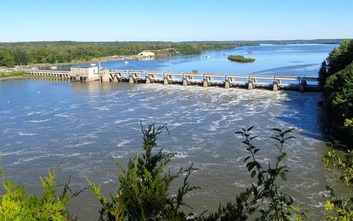
Monday, September 22: OTTAWA
The morning was clear, cool and nearly windless. This was a rest and re-set day. Boating is more than just cruising; it is about relaxing, preparing and enjoying the community. The 10-day forecast created a portrait of ideal cruising with highs in the low 70’s and the nights in the high 40’s. After breakfast, Andiamo was fueled and pumped-out because looking ahead, the price of diesel was high and the availability was low. Sometimes budget is the deciding factor.
While Laurie used the marina’s courtesy car to get to a laundromat and the grocery store, I finished the cleaning the hull and cabin and finished putting water leak repair project with the re-assembly of the affected interior area in the mid-cabin berth. After lunch, we took another courtesy car to Starved Lake State Park, Buffalo Rock State Park and did a driving tour of Ottawa. Ottawa is a healthy small town with traffic, stores, and a vibrant downtown that supports this agricultural area. The rolling hills are beautifully forested with trees that are just beginning to change color.
The morning was clear, cool and nearly windless. This was a rest and re-set day. Boating is more than just cruising; it is about relaxing, preparing and enjoying the community. The 10-day forecast created a portrait of ideal cruising with highs in the low 70’s and the nights in the high 40’s. After breakfast, Andiamo was fueled and pumped-out because looking ahead, the price of diesel was high and the availability was low. Sometimes budget is the deciding factor.
While Laurie used the marina’s courtesy car to get to a laundromat and the grocery store, I finished the cleaning the hull and cabin and finished putting water leak repair project with the re-assembly of the affected interior area in the mid-cabin berth. After lunch, we took another courtesy car to Starved Lake State Park, Buffalo Rock State Park and did a driving tour of Ottawa. Ottawa is a healthy small town with traffic, stores, and a vibrant downtown that supports this agricultural area. The rolling hills are beautifully forested with trees that are just beginning to change color.
Tuesday, September 23: PEORIA
The morning introduced an ideal travel day of clear skies, cool temperatures, still air and nearly mirror flat water. The lines were slipped from the Heritage Harbor Marina before 8 AM and both Andiamo and Chesapeake headed west for the 10 miles to the Starved Rock Lock. The tow traffic was light and none were at the lock but the lock’s gates remained closed as the VHF radio told us that there was an electrical problem with the 1930 technology. We held our breath and waited while the lock staff moved to manual mode. Soon, the lock was operational and we were through the only lock of the day.
Laurie had identified harbors and anchorages along the way but as the miles slipped by at our slow cruising speed, the destination became Peoria that was 65 miles from the lock or a total of 75 miles for the day.
As the scenery and the communities slowly went by, lots of questions were asked: How did the town of Peru get its name? Why is the South Shore Marina on the north shore? Why is the town of Lacon, pronounced in a way that rhymes with bacon?
The first coal-fired power plant revealed that coal was big here. At Big Bend, the Illinois River moves from being an east-west river to a north-south river and the geography changes from being channel-like with bluffs to being a series of lakes with low elevation topography.
The cruising conditions of light breezes, temperatures in the high 70’s with clear skies would remain all day. Andiamo encountered 6 tows and 4 pleasure boats in nine hours of easy cruising.
The end of the cruising day was accented with encountering two massive tows that had passed each other on a narrow portion of the Upper Peoria Lake, a wide lake that is only just deep enough in a narrow channel. Meeting the first tow was easy as we always talk to the captain to get a clear understanding of how to do this safely. Andiamo caught up to the second tow that was also going southbound at a bend in the channel. The tow’s captain appreciated hearing that we would “drag our feet” and “enjoy the view of their rear end.” Afterwards, we slipped by them, motored up to get some distance and then cut over and turned into the Illinois Valley Yacht Club, or IVY, for the night.
Andiamo had traveled 75 miles in 10 hours and was longest mileage for this month.
Peoria is actually a number of communities: Peoria, East Peoria, Peoria Heights, West Peoria and handful of small communities. Together, they form a sizable population that is halfway between Chicago and St. Louis.
The day was closed with a visit from Jeff who is a friend and client. He took us to a Mexican restaurant where the drinks and food were excellent.
The morning introduced an ideal travel day of clear skies, cool temperatures, still air and nearly mirror flat water. The lines were slipped from the Heritage Harbor Marina before 8 AM and both Andiamo and Chesapeake headed west for the 10 miles to the Starved Rock Lock. The tow traffic was light and none were at the lock but the lock’s gates remained closed as the VHF radio told us that there was an electrical problem with the 1930 technology. We held our breath and waited while the lock staff moved to manual mode. Soon, the lock was operational and we were through the only lock of the day.
Laurie had identified harbors and anchorages along the way but as the miles slipped by at our slow cruising speed, the destination became Peoria that was 65 miles from the lock or a total of 75 miles for the day.
As the scenery and the communities slowly went by, lots of questions were asked: How did the town of Peru get its name? Why is the South Shore Marina on the north shore? Why is the town of Lacon, pronounced in a way that rhymes with bacon?
The first coal-fired power plant revealed that coal was big here. At Big Bend, the Illinois River moves from being an east-west river to a north-south river and the geography changes from being channel-like with bluffs to being a series of lakes with low elevation topography.
The cruising conditions of light breezes, temperatures in the high 70’s with clear skies would remain all day. Andiamo encountered 6 tows and 4 pleasure boats in nine hours of easy cruising.
The end of the cruising day was accented with encountering two massive tows that had passed each other on a narrow portion of the Upper Peoria Lake, a wide lake that is only just deep enough in a narrow channel. Meeting the first tow was easy as we always talk to the captain to get a clear understanding of how to do this safely. Andiamo caught up to the second tow that was also going southbound at a bend in the channel. The tow’s captain appreciated hearing that we would “drag our feet” and “enjoy the view of their rear end.” Afterwards, we slipped by them, motored up to get some distance and then cut over and turned into the Illinois Valley Yacht Club, or IVY, for the night.
Andiamo had traveled 75 miles in 10 hours and was longest mileage for this month.
Peoria is actually a number of communities: Peoria, East Peoria, Peoria Heights, West Peoria and handful of small communities. Together, they form a sizable population that is halfway between Chicago and St. Louis.
The day was closed with a visit from Jeff who is a friend and client. He took us to a Mexican restaurant where the drinks and food were excellent.
Three Days to Alton and the Mississippi River
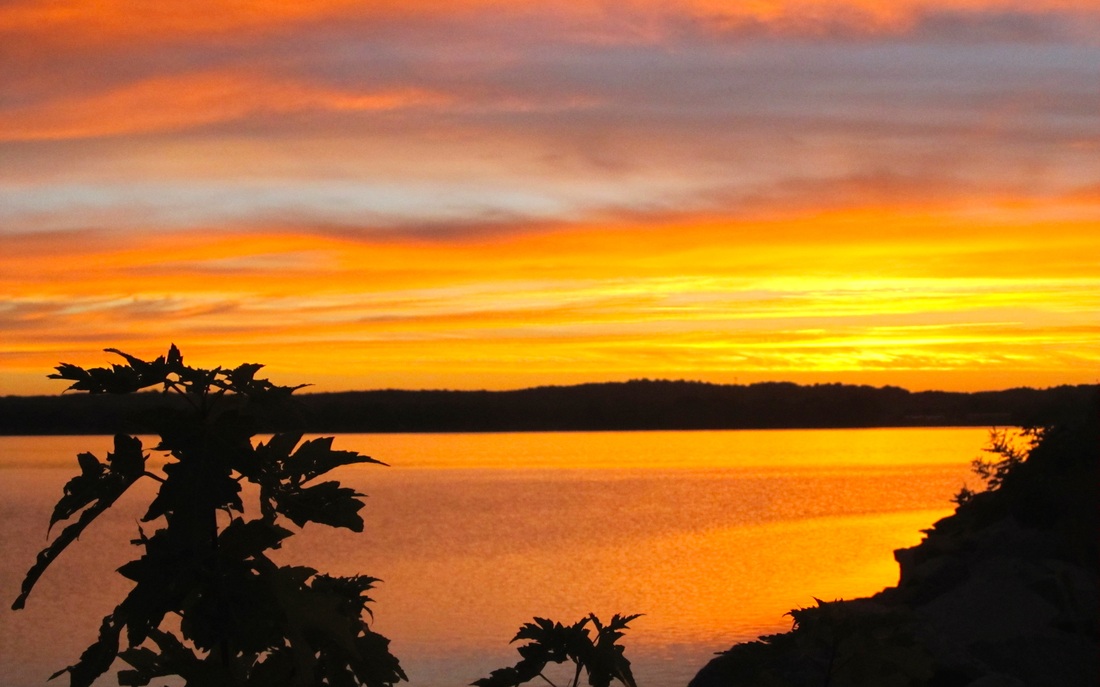
Wednesday, September 24: HAVANA
Foster and Susan were the first out and they would eventually get further down river. Andiamo and Chesapeake were slower. A call to the Peoria Lock revealed the first of several inconsistent messages, “Come on down within the next hour to an hour an a half. We are raising the lake level and putting up the wickets.” Later, we would come to understand that wickets are manually placed and removed vertical panels to hold back the water because Peoria does not have a traditional concrete dam.
By the time the boats had traveled the nine miles and through downtown Peoria, nearly two hours had passed. The lockmaster told a sailboat and then a tow that the lock and dam was closed for about 5 hours to raise the lake level. Our call to the lockmaster revealed the same information, so we turned around and headed to the Peoria town dock, and planned to wait to 3 PM.
The VHF radio channel had been moved from the frequency to talk to the lock to the frequency to talk to the tows that were ahead. The conversation that was heard about later was between a tow captain and the lockmaster where the tow captain said to let the recreational vessels proceed before the wickets are raised because there was room for these boats. The lockmaster then told the sailboat to proceed and Joe on Chesapeake heard that conversation. We turned around, accelerated, and called the lockmaster on the phone who told us to come on down. Yes-No-Yes; sounds like new employees or inconsistent management and it drives one crazy. But, we were grateful to the tug captain for the opportunity he created for us.
Not fully knowing what wickets were, Andiamo idled past the “Maneuver Boat” that was lifting and placing panels across the river. Were we going on some kind of water slide or drop off a waterfall to the laughter to the lock’s employees? No, Andiamo's depth sounder showed that the tug went over a ridge that was 10 feet underneath under the keel.
The Pekin Wiggle is a part of the Illinois River that has several bends and can be challenge to the tows. Andiamo met the tow Mary Scheel for the third time in three days and this illustrated how the tows are in constant motion, moving up and down the river, changing barges, and making deliveries.
Pekin’s name apparently came from a tongue-in-cheek reference to the China’s capital that was thought to be directly under this town and on the other side of the planet. This notion probably went to far when the high school’s team was named the “Chinks” and the mascot was a Chinese man in traditional garb. When the town did not have the sense to see the error of their ways, the school administration had the courage to change it all; today, they are the Dragons.
The cruising was nice and easy with calm flat water and a light breeze with clear skies. Andiamo was “Going with God” by running with the current and traveling 9.4 MPH while earning nearly 5 MPG. Three tows and three pleasure boats were encountered all day. The Illinois River is brown and silted that is probably caused by the tows. Glimmers of corn fields were seen through the willow, maple and cottonwood trees.
Past Coon Hollow Island, Andiamo overtook a 22-foot Tanzer sailboat, one that was identical to our first sailboat. We would see Logan and Ally later at the free dock in Havana. Logan is from New York and is going to New Orleans to start a job. Ally joined the trip just days ago in Chicago, is a musician who is looking forward to the music culture in New Orleans. Both are probably in their mid-20’s, on an adventure, and probably do not know, what they do not know. Their boat is damaged and their equipment is lacking, but they have the spirit and attitude to follow their passion.
Given the choice of a marina, anchorage or the free dock in Havana, we took the free dock. Andiamo had traveled 50 miles in 6 hours.
The bikes took us through the commercial and residential areas of a small town that supports this agricultural area and the roads are in desperate need of repair. We had Frappes at McDonald’s and met an elderly man with “grandpa” sewn on his shirt who volunteered parts of his life’s story: born and raised in Havana, has several farms that his family tends to, and grows corn and soybeans. Pumpkins are another huge crop here along with popcorn. As we talked, the roar of at least 20 trucks carrying corn to the huge grain elevator were seen and heard. Back at Andiamo, another couple with a bad case of “Andiamo Mojo” talked to us for about an hour and we learned parts of their life’s story: she has 5 kids, recently diagnosed with MS, and wants to live life on her terms for the first time. He recently retired after working for 36 years, mostly on second shift; just bought a Harley motorcycle and they came back from a ride to the Blue Ridge Mountains.
After they left, Joe blew his conk shell that signaled the start of happy hour and we had cocktails on Andiamo with Joe and Connie and Logan and Ally. The evening was closed with chicken kabobs on the grill.
Foster and Susan were the first out and they would eventually get further down river. Andiamo and Chesapeake were slower. A call to the Peoria Lock revealed the first of several inconsistent messages, “Come on down within the next hour to an hour an a half. We are raising the lake level and putting up the wickets.” Later, we would come to understand that wickets are manually placed and removed vertical panels to hold back the water because Peoria does not have a traditional concrete dam.
By the time the boats had traveled the nine miles and through downtown Peoria, nearly two hours had passed. The lockmaster told a sailboat and then a tow that the lock and dam was closed for about 5 hours to raise the lake level. Our call to the lockmaster revealed the same information, so we turned around and headed to the Peoria town dock, and planned to wait to 3 PM.
The VHF radio channel had been moved from the frequency to talk to the lock to the frequency to talk to the tows that were ahead. The conversation that was heard about later was between a tow captain and the lockmaster where the tow captain said to let the recreational vessels proceed before the wickets are raised because there was room for these boats. The lockmaster then told the sailboat to proceed and Joe on Chesapeake heard that conversation. We turned around, accelerated, and called the lockmaster on the phone who told us to come on down. Yes-No-Yes; sounds like new employees or inconsistent management and it drives one crazy. But, we were grateful to the tug captain for the opportunity he created for us.
Not fully knowing what wickets were, Andiamo idled past the “Maneuver Boat” that was lifting and placing panels across the river. Were we going on some kind of water slide or drop off a waterfall to the laughter to the lock’s employees? No, Andiamo's depth sounder showed that the tug went over a ridge that was 10 feet underneath under the keel.
The Pekin Wiggle is a part of the Illinois River that has several bends and can be challenge to the tows. Andiamo met the tow Mary Scheel for the third time in three days and this illustrated how the tows are in constant motion, moving up and down the river, changing barges, and making deliveries.
Pekin’s name apparently came from a tongue-in-cheek reference to the China’s capital that was thought to be directly under this town and on the other side of the planet. This notion probably went to far when the high school’s team was named the “Chinks” and the mascot was a Chinese man in traditional garb. When the town did not have the sense to see the error of their ways, the school administration had the courage to change it all; today, they are the Dragons.
The cruising was nice and easy with calm flat water and a light breeze with clear skies. Andiamo was “Going with God” by running with the current and traveling 9.4 MPH while earning nearly 5 MPG. Three tows and three pleasure boats were encountered all day. The Illinois River is brown and silted that is probably caused by the tows. Glimmers of corn fields were seen through the willow, maple and cottonwood trees.
Past Coon Hollow Island, Andiamo overtook a 22-foot Tanzer sailboat, one that was identical to our first sailboat. We would see Logan and Ally later at the free dock in Havana. Logan is from New York and is going to New Orleans to start a job. Ally joined the trip just days ago in Chicago, is a musician who is looking forward to the music culture in New Orleans. Both are probably in their mid-20’s, on an adventure, and probably do not know, what they do not know. Their boat is damaged and their equipment is lacking, but they have the spirit and attitude to follow their passion.
Given the choice of a marina, anchorage or the free dock in Havana, we took the free dock. Andiamo had traveled 50 miles in 6 hours.
The bikes took us through the commercial and residential areas of a small town that supports this agricultural area and the roads are in desperate need of repair. We had Frappes at McDonald’s and met an elderly man with “grandpa” sewn on his shirt who volunteered parts of his life’s story: born and raised in Havana, has several farms that his family tends to, and grows corn and soybeans. Pumpkins are another huge crop here along with popcorn. As we talked, the roar of at least 20 trucks carrying corn to the huge grain elevator were seen and heard. Back at Andiamo, another couple with a bad case of “Andiamo Mojo” talked to us for about an hour and we learned parts of their life’s story: she has 5 kids, recently diagnosed with MS, and wants to live life on her terms for the first time. He recently retired after working for 36 years, mostly on second shift; just bought a Harley motorcycle and they came back from a ride to the Blue Ridge Mountains.
After they left, Joe blew his conk shell that signaled the start of happy hour and we had cocktails on Andiamo with Joe and Connie and Logan and Ally. The evening was closed with chicken kabobs on the grill.
Thursday, September 25: SOUTHWARD THROUGH CENTRAL ILLINOIS
The sky was partly cloudy as the sun rose. There was no dew and the temperatures would be comfortable all day. The day’s trip would take Andiamo through the heart of America’s breadbasket, of tiny communities, massive grain elevators working hard to fill the barges with the summer harvest, and the tows moving the barges to their destination.
The breeze remained light and the river was smooth as it flowed southward with a 2-knot current, creating a peace and serenity of cruising at nearly 10 MPH. Cinnamon rolls were baked filling the tug with a delicious aroma and the satellite radio created the atmosphere. There were almost no houses or evidence of human habitation. The eagles, herons, gulls, hawks and fish owned the river; the tows and the rare cruising boats were visitors. Five tows were met; three of them we had met before, the Mary Scheel, Cooperative Venture and Senator Stennis.
The LaGrange Lock was the last one on the Illinois River. When Laurie called the lockmaster about locking through, he announced that the lock was closed and we could not lock through. There was something in his voice that cued Laurie to ask if the wickets were down and could Andiamo proceed over them. The lockmaster cheerily revealed that was the plan all along and that Laurie had caught on. We joked that perhaps the lock had a small water fall or water slide and wooed the boaters to take it, and the employees and residents placed bets on how the boats would fare. Andiamo slid over the wickets at cruising speed the depth sounder revealing a small blip in the depth and the last lock on this river was behind the tug.
There was more debris and small logs after the dam but these were not a nuisance and this would be norm for the rest of the day. Cell service was gone. Early in the day, Andiamo would catch up to and overtake Logan and Ally. Andiamo did the same with a kayaker who was paddling his nicely finished wood vessel to Louisiana. The feeling of a role reversal came as 30 years ago, we were in the 22 foot sailboat with two young children and the boaters on the yachts would look at us with apprehension. Today, Andiamo was the bigger boat.
At mile marker 61.4 was the Norfolk and Western Railroad Bridge and the most western point of the Great Loop. Now, Andiamo would gradually drift to the east as the tug headed south.
The destination possibilities were three anchorages as there are no marinas or free walls for another 50 miles. Andiamo and Chesapeake took the first one that was behind Big Blue Island at mile marker 57. The channel is probably 150 feet wide and provides great protection, except from the south. The anchor was dropped in 8 feet of water and quickly set, as the southbound current would keep the rode snug. For good practice and peace of mind, a stern anchor was dropped in the unlikely event that the wind would be stronger than the current.
Andiamo had traveled 64 miles in 7 hours. Thus far, over 4,200 miles have been traveled.
While the cockpit shade canvas was being a set up, another canvas repair was needed as the 2011 thread was just failing. After that repair, showers for all and quiet cocktails in this peaceful setting and slice of wonderful river cruising. Joe and Connie came to Andiamo in their dinghy for cocktails and it was one of the few times that a dinghy for Andiamo would have been nice.
The sky was partly cloudy as the sun rose. There was no dew and the temperatures would be comfortable all day. The day’s trip would take Andiamo through the heart of America’s breadbasket, of tiny communities, massive grain elevators working hard to fill the barges with the summer harvest, and the tows moving the barges to their destination.
The breeze remained light and the river was smooth as it flowed southward with a 2-knot current, creating a peace and serenity of cruising at nearly 10 MPH. Cinnamon rolls were baked filling the tug with a delicious aroma and the satellite radio created the atmosphere. There were almost no houses or evidence of human habitation. The eagles, herons, gulls, hawks and fish owned the river; the tows and the rare cruising boats were visitors. Five tows were met; three of them we had met before, the Mary Scheel, Cooperative Venture and Senator Stennis.
The LaGrange Lock was the last one on the Illinois River. When Laurie called the lockmaster about locking through, he announced that the lock was closed and we could not lock through. There was something in his voice that cued Laurie to ask if the wickets were down and could Andiamo proceed over them. The lockmaster cheerily revealed that was the plan all along and that Laurie had caught on. We joked that perhaps the lock had a small water fall or water slide and wooed the boaters to take it, and the employees and residents placed bets on how the boats would fare. Andiamo slid over the wickets at cruising speed the depth sounder revealing a small blip in the depth and the last lock on this river was behind the tug.
There was more debris and small logs after the dam but these were not a nuisance and this would be norm for the rest of the day. Cell service was gone. Early in the day, Andiamo would catch up to and overtake Logan and Ally. Andiamo did the same with a kayaker who was paddling his nicely finished wood vessel to Louisiana. The feeling of a role reversal came as 30 years ago, we were in the 22 foot sailboat with two young children and the boaters on the yachts would look at us with apprehension. Today, Andiamo was the bigger boat.
At mile marker 61.4 was the Norfolk and Western Railroad Bridge and the most western point of the Great Loop. Now, Andiamo would gradually drift to the east as the tug headed south.
The destination possibilities were three anchorages as there are no marinas or free walls for another 50 miles. Andiamo and Chesapeake took the first one that was behind Big Blue Island at mile marker 57. The channel is probably 150 feet wide and provides great protection, except from the south. The anchor was dropped in 8 feet of water and quickly set, as the southbound current would keep the rode snug. For good practice and peace of mind, a stern anchor was dropped in the unlikely event that the wind would be stronger than the current.
Andiamo had traveled 64 miles in 7 hours. Thus far, over 4,200 miles have been traveled.
While the cockpit shade canvas was being a set up, another canvas repair was needed as the 2011 thread was just failing. After that repair, showers for all and quiet cocktails in this peaceful setting and slice of wonderful river cruising. Joe and Connie came to Andiamo in their dinghy for cocktails and it was one of the few times that a dinghy for Andiamo would have been nice.
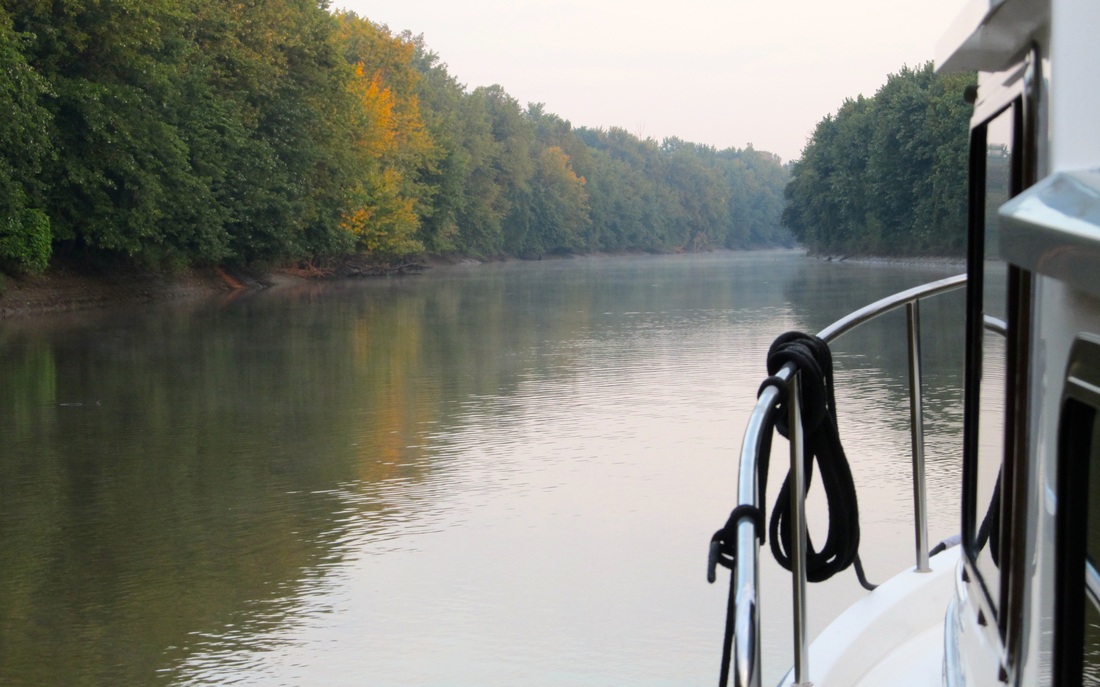
September 26: TO GRAFTON AND THE CONFLUENCE WITH THE MISSISSIPPI RIVER
A morning at anchor is just special and is a reminder to just sometimes forego the easy habit of using at marina. Both anchors were well set but they released from the muddy bottom easily and Andiamo was drifting south in the nearly 2-knot current.
Logan and Ally had arrived close to sunset and were gone at sunrise. Andiamo would catch up and pass them later in the morning and they would go on past us when we stopped at the junction of the Illinois and Mississippi Rivers at the Grafton Marina. They were continuing on down the Mississippi River to New Orleans.
Under clear skies, warm temperatures and only a light breeze from the south, Andiamo skated across the mirror flat river and by the communities of Florence, Pearl, Kampersville Hollow and Grafton. This part of the river had more islands: Willow, Crater, Hurricane, Diamond, Mortland and Twelve Mile. The further south and closer to the Mississippi the tug went, the river was wider and broader. 20 miles from Grafton, cellphone service came back; the first sign of civilization, before roads, houses and cars. 10 miles from Grafton, the first substantial recreational boat traffic was experienced with go-fast fishing boats and medium sized go-fast cruisers.
At 2 PM, we arrived at the Grafton Marina and Andiamo traveled 57 miles in 6 hours. Being at the junction of the Illinois and Mississippi River is another milestone for this adventure. “The Big Muddy” is very busy with tows, commercial boats and recreational boats. Andiamo had gone from being in the rural countryside to high intensity boating.
The marina was nearly full and we were put in the far back, by ourselves and in shallow water. Immediately, the decision was made to only stay one night and to move on Alton, Illinois in the morning.
Susan and Foster were here with at least 6 other looper boats that were unknown to us. We walked into Grafton to stretch our legs, have some outstanding ice cream that was shipped from Wisconsin, and bought a fresh pie, veggies and jam at a vegetable stand. Grafton is busy because the River Road, Highway 67 cuts through it. It is staging a comeback with wineries and breweries and a smattering of antique shops. But contrary to the guidebooks, it is anything but quaint. Cocktails were enjoyed on Chesapeake. A light dinner and a movie closed the evening.
A morning at anchor is just special and is a reminder to just sometimes forego the easy habit of using at marina. Both anchors were well set but they released from the muddy bottom easily and Andiamo was drifting south in the nearly 2-knot current.
Logan and Ally had arrived close to sunset and were gone at sunrise. Andiamo would catch up and pass them later in the morning and they would go on past us when we stopped at the junction of the Illinois and Mississippi Rivers at the Grafton Marina. They were continuing on down the Mississippi River to New Orleans.
Under clear skies, warm temperatures and only a light breeze from the south, Andiamo skated across the mirror flat river and by the communities of Florence, Pearl, Kampersville Hollow and Grafton. This part of the river had more islands: Willow, Crater, Hurricane, Diamond, Mortland and Twelve Mile. The further south and closer to the Mississippi the tug went, the river was wider and broader. 20 miles from Grafton, cellphone service came back; the first sign of civilization, before roads, houses and cars. 10 miles from Grafton, the first substantial recreational boat traffic was experienced with go-fast fishing boats and medium sized go-fast cruisers.
At 2 PM, we arrived at the Grafton Marina and Andiamo traveled 57 miles in 6 hours. Being at the junction of the Illinois and Mississippi River is another milestone for this adventure. “The Big Muddy” is very busy with tows, commercial boats and recreational boats. Andiamo had gone from being in the rural countryside to high intensity boating.
The marina was nearly full and we were put in the far back, by ourselves and in shallow water. Immediately, the decision was made to only stay one night and to move on Alton, Illinois in the morning.
Susan and Foster were here with at least 6 other looper boats that were unknown to us. We walked into Grafton to stretch our legs, have some outstanding ice cream that was shipped from Wisconsin, and bought a fresh pie, veggies and jam at a vegetable stand. Grafton is busy because the River Road, Highway 67 cuts through it. It is staging a comeback with wineries and breweries and a smattering of antique shops. But contrary to the guidebooks, it is anything but quaint. Cocktails were enjoyed on Chesapeake. A light dinner and a movie closed the evening.
Saturday and Sunday, September 27 and 28: TWO DAYS IN ALTON
The pace of the morning started out slow and easy until the river level was noticed to be about one foot lower than last night. Chesapeake and Andiamo were already in shallow water and did not want to be “stuck” in Grafton. The boats were readied and headed down river by mid-morning. The Illinois side had vertical bluffs, rising 150 to 200 feet above the river and the erosion created the image of pillars or what the French called, “Ruined castles.”
The Missouri said was low and forested and it was plain to see which side of the river gets flooded. The great river floods have become the benchmarks of historical time. Where were you during the flood of 1993 where the river rose 38 feet above flood stage, or the floods of 1927 or 1951?
The channel on the Mississippi was three times wider than the Illinois’ and moved from one shore to the other. The charts do not show depth or the location of the floating buoys because of the constant changes to both.
Andiamo arrived in Alton, traveling 18 miles in 2 hours.
The transient moorage is under one covered pier and we were nearly the only boats there. The staff said that low water had kept the loopers out for the past three weeks. Andiamo was re-set with fuel, water and pump-out.
The ideal cruising conditions and the river current created the 4.6 MPG and using 1.84 GPH. The availability of diesel for retail was going to be an issue for the next leg down the Mississippi and up the Ohio Rivers. Andiamo needed full tanks and would have ample range at the tug’s slow cruising speed. The next stop was 60 miles away at Hoppe’s marina and we had a reservation for September 29. Hoppe’s is the only game in-town for recreational boaters and a reservation is necessary.
The bikes took us into Alton and the neighborhood next to the river is depressed and poor with the exception of a two block long section of the business district that is providing a glimmer of what the future could be. The river shore is a nice park with bike and walking paths and connects the riverboat casino to the downtown. A small grocery store was the destination. Their beer selection was problematic; probably because of the proximity to the Anheuser-Bush brewery in St. Louis. The afternoon temperature had risen to the mid-80’s. After it cooled down, we walked to the casino’s buffet dinner.
The pace of the morning started out slow and easy until the river level was noticed to be about one foot lower than last night. Chesapeake and Andiamo were already in shallow water and did not want to be “stuck” in Grafton. The boats were readied and headed down river by mid-morning. The Illinois side had vertical bluffs, rising 150 to 200 feet above the river and the erosion created the image of pillars or what the French called, “Ruined castles.”
The Missouri said was low and forested and it was plain to see which side of the river gets flooded. The great river floods have become the benchmarks of historical time. Where were you during the flood of 1993 where the river rose 38 feet above flood stage, or the floods of 1927 or 1951?
The channel on the Mississippi was three times wider than the Illinois’ and moved from one shore to the other. The charts do not show depth or the location of the floating buoys because of the constant changes to both.
Andiamo arrived in Alton, traveling 18 miles in 2 hours.
The transient moorage is under one covered pier and we were nearly the only boats there. The staff said that low water had kept the loopers out for the past three weeks. Andiamo was re-set with fuel, water and pump-out.
The ideal cruising conditions and the river current created the 4.6 MPG and using 1.84 GPH. The availability of diesel for retail was going to be an issue for the next leg down the Mississippi and up the Ohio Rivers. Andiamo needed full tanks and would have ample range at the tug’s slow cruising speed. The next stop was 60 miles away at Hoppe’s marina and we had a reservation for September 29. Hoppe’s is the only game in-town for recreational boaters and a reservation is necessary.
The bikes took us into Alton and the neighborhood next to the river is depressed and poor with the exception of a two block long section of the business district that is providing a glimmer of what the future could be. The river shore is a nice park with bike and walking paths and connects the riverboat casino to the downtown. A small grocery store was the destination. Their beer selection was problematic; probably because of the proximity to the Anheuser-Bush brewery in St. Louis. The afternoon temperature had risen to the mid-80’s. After it cooled down, we walked to the casino’s buffet dinner.
Back at the marina, we had a new experience: very loud music from a party on several boats. Imagine this: With speakers pointed away from Andiamo and being 75 yards away, the romp and thump was heard and felt in the tug with everything closed and our own music on low. Thinking that Alton would be like every other marina with a quiet time of 11 PM, patience was in order. 1130 PM came and went and I walked over to the 7 people and asked whose boat it was and could the music be lower. The oldest man, in his 50’s, and looking straight at the dock said, “Quiet time starts at midnight and the volume setting is 11, so it is legal.” Our conversation was brief, civil and he repeated his theme three times. He had been visited by the police before.
A neighbor pointed me to a list of phone numbers and I called Greg, the Harbormaster and left a message. The music was turned off at 1230 AM.
The next day, was another beautiful one on the Mississippi River and while changing out the solar panel control and replacing it with one the manufacturer, Morningstar, had sent, Greg left me a voice message that he want to talk about last night. From him, I learned that Alton’s quiet hours on Friday and Saturday do start at midnight but the night security staff should have taken action with the music so loud. Greg was genuinely apologetic and would write a memorandum to the marina manager. I later learned from a marina resident, that very loud parties are a regular occurrence.
Marinas, like every service business and organization only has a few moments to create a reputation and management teams spend more energy on this theme than many other needs. A positive reputation creates good will, new clients and returning customers. Alton spoiled it for us and we wondered if we made a mistake by coming here. They do facility maintenance really well but they do human behavior management really poorly. To their credit, the marina management refunded the moorage fees when the complaint was made.
The performance of the night security staff only reflects the attitude at the top; they did not know about the nuisance or did not care because they did not have to. Genuine apologies aside, Alton has real work ahead of them as they have allowed this party atmosphere to happen and take hold. “You deserve the performance that you tolerate, “ is a theme that they could learn from. Also, the marina management team did not have a system in place where transients could report issues when the office is closed. The bad stuff always happens at night and on the weekend.
The bikes took us to the Three Rivers Museum at the Melvin Price Lock and Dam. The museum was excellent. The take-a-ways: the 29 dams on the upper Mississippi River are intended to keep the river at a depth of 9 feet rather than being for flood control or hydro-electric power. After the Lock 27 near St. Louis, there are no other dams on the Mississippi River.
Jeff and Susan from Gran Vida arrived and we enjoyed catching up with them.
A huge houseboat arrived with music blaring and it took Joe using his boat’s horn to get their attention to turn it down; in over 100 marinas visited on this trip, this one is out of control.
A neighbor pointed me to a list of phone numbers and I called Greg, the Harbormaster and left a message. The music was turned off at 1230 AM.
The next day, was another beautiful one on the Mississippi River and while changing out the solar panel control and replacing it with one the manufacturer, Morningstar, had sent, Greg left me a voice message that he want to talk about last night. From him, I learned that Alton’s quiet hours on Friday and Saturday do start at midnight but the night security staff should have taken action with the music so loud. Greg was genuinely apologetic and would write a memorandum to the marina manager. I later learned from a marina resident, that very loud parties are a regular occurrence.
Marinas, like every service business and organization only has a few moments to create a reputation and management teams spend more energy on this theme than many other needs. A positive reputation creates good will, new clients and returning customers. Alton spoiled it for us and we wondered if we made a mistake by coming here. They do facility maintenance really well but they do human behavior management really poorly. To their credit, the marina management refunded the moorage fees when the complaint was made.
The performance of the night security staff only reflects the attitude at the top; they did not know about the nuisance or did not care because they did not have to. Genuine apologies aside, Alton has real work ahead of them as they have allowed this party atmosphere to happen and take hold. “You deserve the performance that you tolerate, “ is a theme that they could learn from. Also, the marina management team did not have a system in place where transients could report issues when the office is closed. The bad stuff always happens at night and on the weekend.
The bikes took us to the Three Rivers Museum at the Melvin Price Lock and Dam. The museum was excellent. The take-a-ways: the 29 dams on the upper Mississippi River are intended to keep the river at a depth of 9 feet rather than being for flood control or hydro-electric power. After the Lock 27 near St. Louis, there are no other dams on the Mississippi River.
Jeff and Susan from Gran Vida arrived and we enjoyed catching up with them.
A huge houseboat arrived with music blaring and it took Joe using his boat’s horn to get their attention to turn it down; in over 100 marinas visited on this trip, this one is out of control.
Going to PADUCAH, kentucky: 4 Days on The mississippi and ohio rivers
Monday, September 29: ALTON IL TO HOPPIES MARINA, MISSOURI
Alton was left just after sunrise and besides Chesapeake, two other boats from the marina joined us and would stay with us the whole day. Once again, the weather was perfect for cruising with clear skies, light winds, smooth water and temperatures in the high 70’s.
Immediately after the marina, was the Melvin Price Lock and Dam that operates two locking chambers. Laurie had phoned the lockmaster before leaving and the lock was ready for us and we entered without any waiting. Four recreational boats in a lock that can hold 15 barges and a tow made the empty space in this lock huge.
After dropping about 20 feet and continuing down the river and through a heavy concentration of barges and tows, Andiamo came to the confluence of the Missouri River. The junction is not signed and is unremarkable but the amount of water coming created a moderate turbulence. Immediately afterward, is a canal for the boats to take to the Chain of Rocks Lock. At this junction, the Army Corps of Engineers has erected a huge sign directing all boats down this canal. The main river channel bends to the west and is essentially miles of boulders and moderate rapids. Apparently, it was cheaper and easier to dig a new canal than to remove the obstacles in the main river channel.
About 12 miles, the canal ends with the lock and dam and Lock 27 is the last dam on the Mississippi River and delineates the Lower Mississippi River from the Upper Mississippi River. The smaller lock chamber was ready and waiting for us and we dropped about 5 feet. Immediately upon exiting, we were alongside a tow that had just left the large lock chamber and we opted to stay behind it through the tight turns and the narrow channel that was near the lock. On the Mississippi River, the tows own the right-of-way; pleasure boaters are merely visitors.
The river’s current met the advertising; it was fast and about 3 MPH. Soon, Andiamo was traveling 11 MPH at its slow cruising RPM. Under bridges and past barges moored to the shoreline, and finally under Eads Bridge, Andiamo arrived at the foot of the Gateway Arch that is 630 feet high. 36 years ago to the month, Laurie and I met here as new park rangers. The grounds had been transformed, and the riverfront had been developed, but the core of the site remained unchanged.
Past the Gateway Arch, St. Louis was entirely heavy industrial with many terminals for barges for loading and unloading. Then, came the services that repaired the barges and the tows. This sight was not ugly or unpleasant; rather, it was a reminder of the infrastructure and effort to move the bulk goods that are important parts of the country’s economy.
After a few miles, the density of human activity faded. Though the Mississippi is not wild, it is barely controlled and the water was dynamic with swirls, eddies, and a slight chop. Wing dams were a frequent sight; short, rock walls that strutted out from the shoreline and being slightly angled to downstream, these are built to channel the river’s current to the center and keeps the depth more uniform. As a boater, you do not want to go over a partially submerged wing dam. The mantra is to keep to the center of the river at all times.
The destination was Hoppies Marina, which is really a set of low steel barges that parallel the shoreline near Imperial, Missouri and is a half-mile from Kimmswick. Andiamo and the group arrived in the early afternoon, travelling 44 miles in 6 hours and that included two locks.
Alton was left just after sunrise and besides Chesapeake, two other boats from the marina joined us and would stay with us the whole day. Once again, the weather was perfect for cruising with clear skies, light winds, smooth water and temperatures in the high 70’s.
Immediately after the marina, was the Melvin Price Lock and Dam that operates two locking chambers. Laurie had phoned the lockmaster before leaving and the lock was ready for us and we entered without any waiting. Four recreational boats in a lock that can hold 15 barges and a tow made the empty space in this lock huge.
After dropping about 20 feet and continuing down the river and through a heavy concentration of barges and tows, Andiamo came to the confluence of the Missouri River. The junction is not signed and is unremarkable but the amount of water coming created a moderate turbulence. Immediately afterward, is a canal for the boats to take to the Chain of Rocks Lock. At this junction, the Army Corps of Engineers has erected a huge sign directing all boats down this canal. The main river channel bends to the west and is essentially miles of boulders and moderate rapids. Apparently, it was cheaper and easier to dig a new canal than to remove the obstacles in the main river channel.
About 12 miles, the canal ends with the lock and dam and Lock 27 is the last dam on the Mississippi River and delineates the Lower Mississippi River from the Upper Mississippi River. The smaller lock chamber was ready and waiting for us and we dropped about 5 feet. Immediately upon exiting, we were alongside a tow that had just left the large lock chamber and we opted to stay behind it through the tight turns and the narrow channel that was near the lock. On the Mississippi River, the tows own the right-of-way; pleasure boaters are merely visitors.
The river’s current met the advertising; it was fast and about 3 MPH. Soon, Andiamo was traveling 11 MPH at its slow cruising RPM. Under bridges and past barges moored to the shoreline, and finally under Eads Bridge, Andiamo arrived at the foot of the Gateway Arch that is 630 feet high. 36 years ago to the month, Laurie and I met here as new park rangers. The grounds had been transformed, and the riverfront had been developed, but the core of the site remained unchanged.
Past the Gateway Arch, St. Louis was entirely heavy industrial with many terminals for barges for loading and unloading. Then, came the services that repaired the barges and the tows. This sight was not ugly or unpleasant; rather, it was a reminder of the infrastructure and effort to move the bulk goods that are important parts of the country’s economy.
After a few miles, the density of human activity faded. Though the Mississippi is not wild, it is barely controlled and the water was dynamic with swirls, eddies, and a slight chop. Wing dams were a frequent sight; short, rock walls that strutted out from the shoreline and being slightly angled to downstream, these are built to channel the river’s current to the center and keeps the depth more uniform. As a boater, you do not want to go over a partially submerged wing dam. The mantra is to keep to the center of the river at all times.
The destination was Hoppies Marina, which is really a set of low steel barges that parallel the shoreline near Imperial, Missouri and is a half-mile from Kimmswick. Andiamo and the group arrived in the early afternoon, travelling 44 miles in 6 hours and that included two locks.
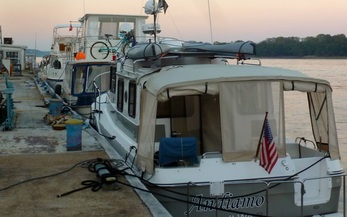
Hoppies is an institution for loopers and is operated by the matriarch, Fern, and her sons. Hoppies has been operating as a marina for nearly 80 years, before there were volumes of rules and regulations and will probably not exist in the future when the family ends its ownership. Fern sells diesel, provides power and water, but not toilets, showers or Internet. Her marina can handle about 8 boats and reservations are necessary. The conditions are not fancy, just basic and Fern holds court every afternoon with the boaters to share her knowledge and wisdom of the river’s current condition, the challenges, and the anchorages in this next leg. Between Hoppies and the Green Turtle Bay Marina in Kentucky, there are no marinas, fuel or water, just 250 miles of the Mississippi, Ohio, and Cumberland Rivers.
After lunch, the bikes took us to Kimmswick, the second oldest town in Missouri that is four blocks square of shops, businesses and some original homes. Every business was closed today, as they are every Monday. This must be town ordinance as having every business closed, with no services anywhere, is a first for us. Cycling another ¾ of a mile took as to the junction of the Interstate and a vibrant small town where we bought beer.
Back at the marina, Fern delivered her lecture and most of the boaters are leaving in the morning for either a destination that is 42 miles away or 110 miles away. A storm front is forecasted for Thursday.
The evening was closed with cocktails with Joe and Connie and then a dinner of tacos and fruit salad.
After lunch, the bikes took us to Kimmswick, the second oldest town in Missouri that is four blocks square of shops, businesses and some original homes. Every business was closed today, as they are every Monday. This must be town ordinance as having every business closed, with no services anywhere, is a first for us. Cycling another ¾ of a mile took as to the junction of the Interstate and a vibrant small town where we bought beer.
Back at the marina, Fern delivered her lecture and most of the boaters are leaving in the morning for either a destination that is 42 miles away or 110 miles away. A storm front is forecasted for Thursday.
The evening was closed with cocktails with Joe and Connie and then a dinner of tacos and fruit salad.
Tuesday, September 30,: 110 MILES TO CAPE GIRARDEAU, MISSOURI
Like nearly everyone else at Hoppies, we were up before sunrise and all the boats left within 30 minutes of each other with nearly everyone planning on going a long distance. There were two fast cruisers and they talked of going to the Ohio River that was over 150 miles away. Most everyone else talked of going 110 miles to Cape Girardeau, Missouri and to a diversion canal off of the Mississippi River. This part of the loop not only has no marinas but very limited anchorages.
Andiamo would spend the next 10 hours running at 1950 RPM’s and traveling between 11 and 12 MPH because of the nearly 4 MPH current. Chesapeake would follow us and then two other boats. The four go-fast cruisers left us within the first hour. This was another ideal cruising day with clear or very high clouds, light or no winds, and warm. The water conditions were a full spectrum of being on a flat table top to bumping and pitching in the high wakes that were caused by tows or fast cruisers. Along the route, Andiamo negotiated moderate to severe turbulence and whirlpools a handful times that were caused by the upwelling of current from a deep bottom.
Tows, being tugs and barges, were the constant event and Andiamo encountered 33 of them. Most were easy to pass or overtake and a couple required that we wait for them to navigate a narrow bend. Laurie was the voice of Andiamo with the tows. The AIS-equipped Garmin chartplotter was the best tool because the tow’s name, speed, and location were displayed on the screen and Andiamo sent the same information. They knew about us and we knew about them. Having AIS (automated identification system) is like having underwear: I don’t have to have it, but having it makes boating really comfortable.
20 miles into the trip and after going through a turbulent stretch, Andiamo developed a vibration that was felt in the helm and in the hull. The vibration got worse at higher RPM’s and an inspection of the engine with the infrared thermometer showed no issues. Nothing was seen looking over the transom and into the murky water. Did the propeller get bent on a submerged log? Was the prop shaft bent? Was the cutlass bearing shot? Was the alignment between the transmission and the propeller out of alignment? Did the shaft coupling just fail? Andiamo was over 200 miles away from a marina with a haul-out, would it make it there? Is a tow necessary? Is it going to get worse? What are the options?
These questions and feelings of apprehension swirled around. Joe, on Chesapeake, suggested stopping and putting the engine in reverse to free anything snagged under the waterline. That was the fix and whatever was caught on the running gear was gone and Andiamo was silky smooth once again. We celebrated our good fortune with fresh, warm cookies from the oven.
The river and the scenery were interesting but with little variety, though not in a bad way as the cruising was delightful. On some stretches, the high bank was on the Missouri side and the lowlands, where it would flood, were on the Illinois side; while at other stretches, it was the reverse. Missouri had at least half-dozen huge quarries and cement batching plants. Several coal-fired power plants were passed, some were in use with full barges of coal waiting to be unloaded, and others looked shutdown. Coal was being loaded at a handful of sites in Illinois and would be moved northward.
As river travelers, we became consumers of the Army Corps of Engineers planning, design, and construction: the buoys, the wing dams, the weir dams and the sculptured shoreline. Those features were talked about, appreciated and avoided.
What was notable was the near total absence of people. Except for the towns of Chester and Cape Girardeau and a smattering of industrial sites, the river’s shore put on a face of being a wilderness. However, what was missing was wildlife of any kind. No birds, no mammals and with the absence of any commercial or sport fishing, there was probably no fish. Was the Mississippi an ecological dead zone that had only one purpose, to move barges?
In the late afternoon, Andiamo arrived at the canal diversion at Cape Girardeau having traveled 110 miles in 10 hours. The anchor was dropped behind two other boats from Hoppies and Chesapeake rafted to us. We had a celebratory beer and later a shared dinner on their boat.
Andiamo had taken us over 900 miles in September, a record amount that was not intended. We have intended to not rush or push the trip and certainly to not have a schedule. Looking back, the weather dictated the travelling in the first half of the month and the lack of places to stop and explore made the travelling necessary in the second half of the month.
The tug has taken us over 4,500 miles on this adventure.
Like nearly everyone else at Hoppies, we were up before sunrise and all the boats left within 30 minutes of each other with nearly everyone planning on going a long distance. There were two fast cruisers and they talked of going to the Ohio River that was over 150 miles away. Most everyone else talked of going 110 miles to Cape Girardeau, Missouri and to a diversion canal off of the Mississippi River. This part of the loop not only has no marinas but very limited anchorages.
Andiamo would spend the next 10 hours running at 1950 RPM’s and traveling between 11 and 12 MPH because of the nearly 4 MPH current. Chesapeake would follow us and then two other boats. The four go-fast cruisers left us within the first hour. This was another ideal cruising day with clear or very high clouds, light or no winds, and warm. The water conditions were a full spectrum of being on a flat table top to bumping and pitching in the high wakes that were caused by tows or fast cruisers. Along the route, Andiamo negotiated moderate to severe turbulence and whirlpools a handful times that were caused by the upwelling of current from a deep bottom.
Tows, being tugs and barges, were the constant event and Andiamo encountered 33 of them. Most were easy to pass or overtake and a couple required that we wait for them to navigate a narrow bend. Laurie was the voice of Andiamo with the tows. The AIS-equipped Garmin chartplotter was the best tool because the tow’s name, speed, and location were displayed on the screen and Andiamo sent the same information. They knew about us and we knew about them. Having AIS (automated identification system) is like having underwear: I don’t have to have it, but having it makes boating really comfortable.
20 miles into the trip and after going through a turbulent stretch, Andiamo developed a vibration that was felt in the helm and in the hull. The vibration got worse at higher RPM’s and an inspection of the engine with the infrared thermometer showed no issues. Nothing was seen looking over the transom and into the murky water. Did the propeller get bent on a submerged log? Was the prop shaft bent? Was the cutlass bearing shot? Was the alignment between the transmission and the propeller out of alignment? Did the shaft coupling just fail? Andiamo was over 200 miles away from a marina with a haul-out, would it make it there? Is a tow necessary? Is it going to get worse? What are the options?
These questions and feelings of apprehension swirled around. Joe, on Chesapeake, suggested stopping and putting the engine in reverse to free anything snagged under the waterline. That was the fix and whatever was caught on the running gear was gone and Andiamo was silky smooth once again. We celebrated our good fortune with fresh, warm cookies from the oven.
The river and the scenery were interesting but with little variety, though not in a bad way as the cruising was delightful. On some stretches, the high bank was on the Missouri side and the lowlands, where it would flood, were on the Illinois side; while at other stretches, it was the reverse. Missouri had at least half-dozen huge quarries and cement batching plants. Several coal-fired power plants were passed, some were in use with full barges of coal waiting to be unloaded, and others looked shutdown. Coal was being loaded at a handful of sites in Illinois and would be moved northward.
As river travelers, we became consumers of the Army Corps of Engineers planning, design, and construction: the buoys, the wing dams, the weir dams and the sculptured shoreline. Those features were talked about, appreciated and avoided.
What was notable was the near total absence of people. Except for the towns of Chester and Cape Girardeau and a smattering of industrial sites, the river’s shore put on a face of being a wilderness. However, what was missing was wildlife of any kind. No birds, no mammals and with the absence of any commercial or sport fishing, there was probably no fish. Was the Mississippi an ecological dead zone that had only one purpose, to move barges?
In the late afternoon, Andiamo arrived at the canal diversion at Cape Girardeau having traveled 110 miles in 10 hours. The anchor was dropped behind two other boats from Hoppies and Chesapeake rafted to us. We had a celebratory beer and later a shared dinner on their boat.
Andiamo had taken us over 900 miles in September, a record amount that was not intended. We have intended to not rush or push the trip and certainly to not have a schedule. Looking back, the weather dictated the travelling in the first half of the month and the lack of places to stop and explore made the travelling necessary in the second half of the month.
The tug has taken us over 4,500 miles on this adventure.
Wednesday, October 1: UP THE OHIO RIVER
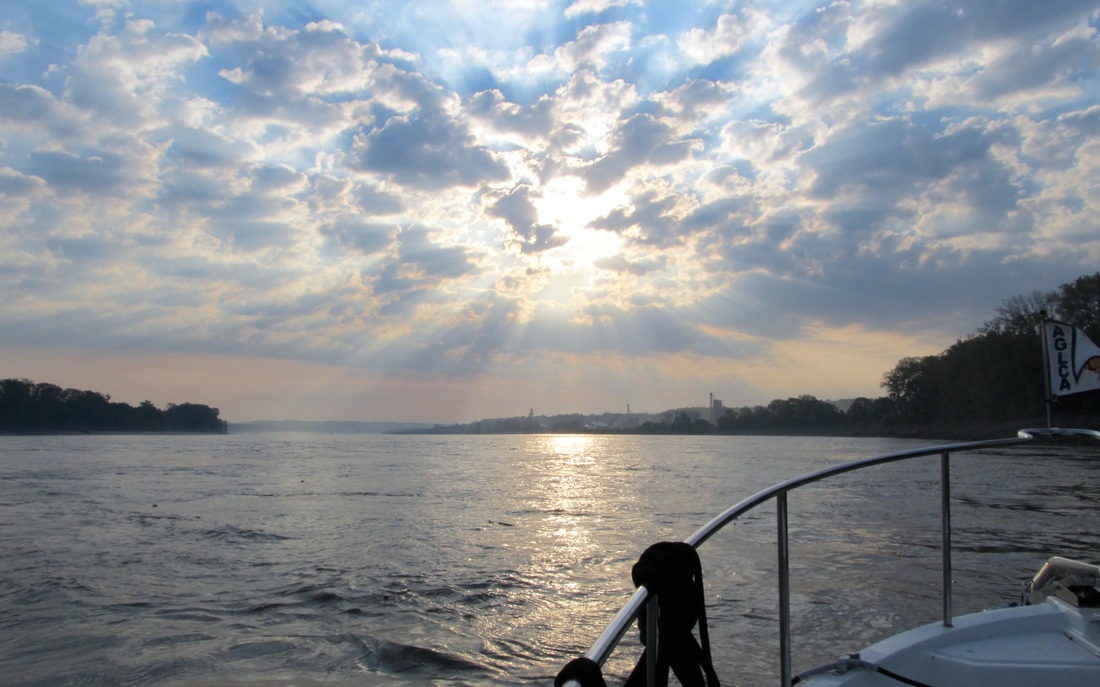
The go-fast cruisers were the first ones to leave on this calm morning where the skies were partly cloudy and the sun’s rays poured them creating what a photographer had described as “God talk.”
Andiamo and Chesapeake were the last to leave anchorage because we had no illusions of trying to make it to Paducah, Kentucky and over a hundred miles. The Mississippi accepted us like a conveyor at an airport takes luggage; firmly and quickly and within minutes Andiamo was traveling 11.5 MPH at its slow cruising speed. Soon, the topography at this part of the Mississippi was low and flat and this giant river was swinging back and forth creating huge serpent like oxbows where 15 miles of river travel was necessary to go 5 miles as the crow flies. On the last turn of the oxbow, the river pushed the tug along at 15 MPH for about 15 seconds. The Mississippi was giving us a send off.
Shortly after noon, Andiamo arrived at the junction with the Ohio River and it was plain to see where the two bodies of water met. The “Big Muddy” of the Mississippi met the blue water of the Ohio. Turning to the northeast, Andiamo was going up stream and the fight with the Ohio’s 1.5 MPH current would reduce the tug’s speed to 6.5 MPH.
The town of Cairo, Illinois is at the junction of these rivers. Named for being on the “Nile of America” the name is pronounced “Kay-row” by everyone and has failed to take advantage of every the opportunity in geography or history that it was given. Except for the huge amount of barge-related industry, the town is a shell with virtually no economy, and with the mammoth floodwall encircling it; it looked like a medieval city that is under siege. Andiamo continued on, as there are no opportunities to stop. Cairo has turned its back on those who use the river.
Snaking by parked packs of barges in the river but off of the main channel, Andiamo was traveling with the fresh south breeze that was kicking up a slight chop. The Olmstead Dam is being built and we marveled at this huge construction project and what is possible when the brightest people have funding and a clear purpose. Andiamo and Chesapeake traveled over the wickets at Dam 53 and avoided the lock. We knew that the wickets were already up at Dam 52 and this would require locking through.
The late afternoon required settling on one of the options to anchor. Laurie had researched Active Captain, Skipper Bob, and the Doyle’s guide and had 5 options. Andiamo powered up to look over the first option that was described in two of the sources while Chesapeake continued at 6.5 MPH. None of the options are ideal, all of them are on the river with no protection from wakes but only two had protection from the predicted stronger south wind that would come later tonight. We took the first opportunity and dropped the anchored in 8 feet of water.
We had drinks and dinner on Chesapeake, enjoying Joe and Connie’s company.
Andiamo had traveled 78 miles in 8 hours.
Thursday, October 2: TO THE JUNCTION WITH THE CUMBERLAND RIVER
The morning was cloudy and would be the precursor to the thunderstorms that would later. Andiamo’s anchor was pulled at sunrise because there was concern about how long the wait would be at Lock 52 due to the number of tows that the AIS should were waiting on each side of the lock. The river’s current kept Andiamo’s speed at no more than 6.6 MPH at our slow cruising RPM. Though we could have motored up and easily done twice that speed, there was simply no point to it.
Past the town of Metropolis, Illinois and their embracing of the Superman story, came two bridges and Lock 52. Several days ago, their wickets were down and pleasure boats were continuing through with having to lock through with the commercial tows. Now, the wickets were up to raise the water level. Andiamo spent two hours with Chesapeake and two other pleasure boats waiting for lockage through the smaller of the two lock chambers. Waiting meant constantly operating the tug at very slow speeds, idling, turning and drifting, and staying away from each other and the tows. Commercial tows have priority over pleasure boats and that means patience is needed. Tow captains have their own unique language. For instance, when the tug and the barges are in the lock and the lock’s gates are closed, this is described as, “The head is stuck in the hole.”
After the lock, Andiamo and Chesapeake were traveling behind two other pleasure boats and we discovered that four boats are just too many to travel together. You find yourself either being annoyed at their speed, too fast or too slow, or being irritated that you are thinking like a lemming and not making decisions.
The wind was building from the south and was in opposition to the river current, this caused a wind-over-current chop that was short and steep but Andiamo was going with it. To the north, the storm cells were darker and fuller across the sky. Central Illinois was getting pounded with rain and wind.
Andiamo passed the mouth of the Tennessee River and continued to the Cumberland River because the Tennessee River is dominated by heavy tow traffic and the lock at the Kentucky Dam had a well-earned reputation for being unfriendly to pleasure boat traffic. They wanted the pleasure boats to use the Cumberland River Lock and Dam and we were happy to cooperate. At the mouth of the Cumberland, we had a decision to make; with 6 hours of daylight left, either we push on 30 miles up the Cumberland River and potentially arrive at the Green Turtle Bay Marina at sunset or anchor behind an island and ride out the coming wind, rain and thunderstorm.
Our high level of fatigue from the previous long cruising days and the effort used to wait at Lock 52 dictated the decision to anchor and rest. Both Active Captain.com and the guidebooks recommended the anchorage behind a tow island at the mouth of the Cumberland River. The anchor was dropped in 10 feet of water. Because the current was going south and the wind was going north, these forces were in constant competition on which was going dominate Andiamo. Most of the time it was a tie, and the tug would lie sideways in the channel as the current pushed on one side and the wind would push on the other side.
The wind rose for an hour in the afternoon and then was completely still at sunset. Three little deer came down to the water’s edge. A tornado watch was issued for the entire region. This alerted us but the context is that this happens a lot and a watch is not a warning. We readied extra gear that included a second anchor, if it was needed. The Weatherbug app was watched and Andiamo missed the main body of the storm as it headed north.
The evening was punctuated with lightning and thunder. At midnight, Laurie awoke to the roar of the wind as a 45 to 60 MPH gust blew through us and Andiamo strained hard on the anchor; 60 feet of rode and the Ultra Anchor refused to drag. Then, the torrents of rain hit fast and hard. The beam of the flashlight did not penetrate past 10 feet. In an hour, the storm cell had passed through leaving a steady wind that would last throughout the next day.
The morning was cloudy and would be the precursor to the thunderstorms that would later. Andiamo’s anchor was pulled at sunrise because there was concern about how long the wait would be at Lock 52 due to the number of tows that the AIS should were waiting on each side of the lock. The river’s current kept Andiamo’s speed at no more than 6.6 MPH at our slow cruising RPM. Though we could have motored up and easily done twice that speed, there was simply no point to it.
Past the town of Metropolis, Illinois and their embracing of the Superman story, came two bridges and Lock 52. Several days ago, their wickets were down and pleasure boats were continuing through with having to lock through with the commercial tows. Now, the wickets were up to raise the water level. Andiamo spent two hours with Chesapeake and two other pleasure boats waiting for lockage through the smaller of the two lock chambers. Waiting meant constantly operating the tug at very slow speeds, idling, turning and drifting, and staying away from each other and the tows. Commercial tows have priority over pleasure boats and that means patience is needed. Tow captains have their own unique language. For instance, when the tug and the barges are in the lock and the lock’s gates are closed, this is described as, “The head is stuck in the hole.”
After the lock, Andiamo and Chesapeake were traveling behind two other pleasure boats and we discovered that four boats are just too many to travel together. You find yourself either being annoyed at their speed, too fast or too slow, or being irritated that you are thinking like a lemming and not making decisions.
The wind was building from the south and was in opposition to the river current, this caused a wind-over-current chop that was short and steep but Andiamo was going with it. To the north, the storm cells were darker and fuller across the sky. Central Illinois was getting pounded with rain and wind.
Andiamo passed the mouth of the Tennessee River and continued to the Cumberland River because the Tennessee River is dominated by heavy tow traffic and the lock at the Kentucky Dam had a well-earned reputation for being unfriendly to pleasure boat traffic. They wanted the pleasure boats to use the Cumberland River Lock and Dam and we were happy to cooperate. At the mouth of the Cumberland, we had a decision to make; with 6 hours of daylight left, either we push on 30 miles up the Cumberland River and potentially arrive at the Green Turtle Bay Marina at sunset or anchor behind an island and ride out the coming wind, rain and thunderstorm.
Our high level of fatigue from the previous long cruising days and the effort used to wait at Lock 52 dictated the decision to anchor and rest. Both Active Captain.com and the guidebooks recommended the anchorage behind a tow island at the mouth of the Cumberland River. The anchor was dropped in 10 feet of water. Because the current was going south and the wind was going north, these forces were in constant competition on which was going dominate Andiamo. Most of the time it was a tie, and the tug would lie sideways in the channel as the current pushed on one side and the wind would push on the other side.
The wind rose for an hour in the afternoon and then was completely still at sunset. Three little deer came down to the water’s edge. A tornado watch was issued for the entire region. This alerted us but the context is that this happens a lot and a watch is not a warning. We readied extra gear that included a second anchor, if it was needed. The Weatherbug app was watched and Andiamo missed the main body of the storm as it headed north.
The evening was punctuated with lightning and thunder. At midnight, Laurie awoke to the roar of the wind as a 45 to 60 MPH gust blew through us and Andiamo strained hard on the anchor; 60 feet of rode and the Ultra Anchor refused to drag. Then, the torrents of rain hit fast and hard. The beam of the flashlight did not penetrate past 10 feet. In an hour, the storm cell had passed through leaving a steady wind that would last throughout the next day.
JUST FOR FUN AND OTHER CONTRADICTIONS
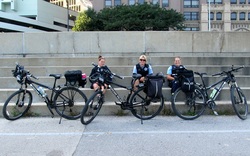
Bike Cops enjoying the day on the lakeshore.
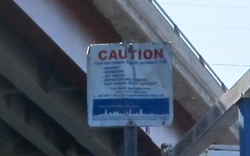
This sign is all over the Sanitary and Ship Canal. The most important line, "Do not have contact whatsoever with the water."
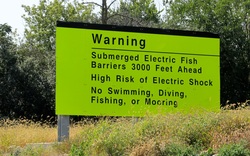
This water is just nasty!

Funding is so low at a state park that they cannot afford all the letters for their bulletin board.
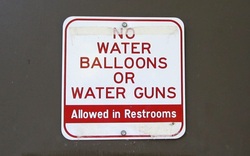
Some rules just do not make any sense.
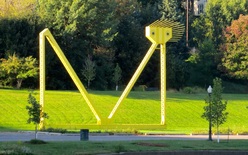
What does it mean?
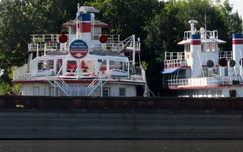
Two former casino/restaurant steamboats in mothballs with old barges and the sign is still inviting.
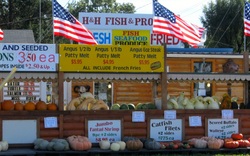
Food and signs say a lot about a community.
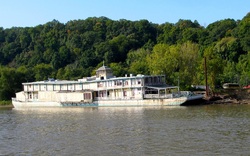
Imagine all the useful purposes a former river cruiser with rooms and dining facilities could be used for. Things that communities do not want all the time but would tolerate for several weeks or month.
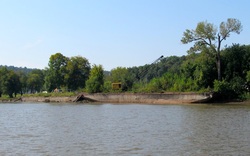
A good use of old barges? Just beach them, fill them with dirt and it becomes a park and an instant breakwater.
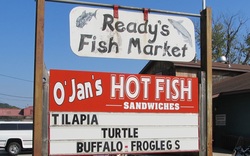
Illinois is a transition state between north and south. The farther south in the state, the more southern it becomes. Buffalo Froglegs? Is that genetically possible?

Buffalo Eggs; totally self-explanatory.
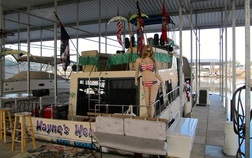
Boat decor that is taken to whole new level. Grafton Marina brands itself as the "Key West on the Midwest." Do they really know what they are saying?
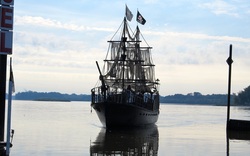
There are pirates on the river.

Not sure what it means but it is eye catching on the Mississippi River.

Within seconds of the above image, came this one. Is it a theme of the neighborhood: Not sure what it means, but it is eye catching.
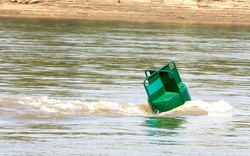
What does a 4 MPH current on the Mississippi River look like?
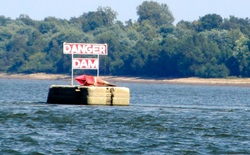
You would think that some things do not have to be said.

























